Ganesha Maha Mantra: Ganesha's Mantra

Table of contents
Among the many deities of Hindu mythology, some stand out, such as Ganesha. Described as a figure with the body of a human being and the head of an elephant, as well as a prominent belly, four arms, a single tusk, and a mouse at his feet, Ganesha is worshiped as the god of good fortune and wisdom, and is worshiped mainly by merchants, businessmen, or ambitious people.
In addition, Ganesha is also known as Vinakaya, which in Sanskrit means "destroyer of obstacles," so he is considered the ultimate god of logical consciousness, able to find solutions to all problems that stand in the way.
As for his characteristics, the elephant head of this deity represents his great wisdom and intellect, the belly symbolizes his patience and his ability to digest the bad and good that life offers, his only tusk is a reference to the sacrifices we must make to conquer our dreams and goals, and the mouse is a reference to investigating the offal of problems andsituations that are considered difficult.
Ganesha's mantra
There are two very popular mantras to invoke Ganesha's protection and help. The first one, probably the most famous in Hindu mythology, is Omkara, which is the prolonged repetition of the sound "Om", known as the primordial sound.
There is an "extended version" of this mantra, a little less popular, but still well known: "Om Gam Ganapataye Namaha". (pronounced: om gam ganapataiê namarrá) In a simple translation from Sanskrit to Portuguese, it would be something like: "I salute You, Lord of the Troops.

Rob King / Unsplash
To understand the particularities of the meaning of this mantra, it is possible to study it word by word:
- "OM" is the primordial invocation and establishes contact between the practitioner and Ganesha.
- "GAM" is a verb that in Sanskrit means "to go, to move, to move away, to come, to draw near, to join"; in this mantra, it is a sacred syllable that represents Lord Ganesha himself.
- "GANAPATI" The word can be divided in two: GANA means TROOP and PATI means LORD.
- "NAMAS" is worship; in the mantra it appears as NAMAH.
There is an even longer version for the mantra: Om Gam Ganapataye Namaha, Sharanam Ganesha. "Shanaram" in Sanskrit means "refuge" or "protection", so chanting this mantra in its longer version is very positive in times of extreme danger, threat, or need.
What is Ganesha's mantra for?
The Ganesha Maha Mantra, as it is known, is considered very powerful, because it has an immediate power of protection when it is chanted in situations of imminent danger, such as the risk of assault, or even in situations of fighting and conflict.
As he is known as the Lord of Troops and the Opener of Paths, Ganesha brings relief to troublesome, troubling, and dangerous situations, so by invoking him with this mantra, you ask for his immediate protection for anything that is troubling your heart, hindering your advancement, or posing danger.
Other benefits of the mantra: connection with the god Ganesha, attraction of positive energies to the environment, spiritual evolution, elimination of negative energy after disagreements, fighting lack of motivation, among others.
What is the best way to chant Ganesha's mantra?
There is no right time to chant Ganesha's mantra. It can be chanted in a dangerous situation, when you want the immediate protection of this deity (taking care, of course, not to expose yourself to even more dangers, like in a robbery situation, for example), but also throughout the day, asking for his preventive protection against any evil that may come your way. Another goodThe moment to chant the mantra is, of course, during meditation, when we are concentrated in our contact with ourselves and with the deities, being one with the whole.
There is a recommendation that the mantra be repeated for 108 times for 10 consecutive days for those who want to potentiate its energies.
Listen to Ganesha's mantra for prosperity below:
How to thank Lord Ganesha?
Ganesha is a god associated with music, celebration, and joy, so a good way to thank this deity is by singing and chanting his mantra with joy at the times you wish to thank him.
Many followers of Hinduism usually offer incense to pay their respects and thanks to Ganesha. Another well known thanksgiving ritual is to light a fire in a cauldron and burn bay leaves while reciting the mantra, but always in a joyful way, thanking for the deliverances and visualizing your paths being opened and those wishes you so much dream of conqueringfinally being achieved.
You may also like
- What can you learn from Ganesha?
- Lord Ganesha - Meet the obstacle-destroying god
- How to do the om mantra?
- Learn about the Indian gods and their respective symbologies!
- OM and its meaning
According to the followers of Hinduism, Ganesha is a god who always keeps his ears open, so a good option is to have a statue of him in some environment of your house, to always be in direct contact with him, chanting his mantras or even talking to this god.
See_also: Muladhara - All about the Root ChakraIt is important, whenever possible, to wash the statue with fresh water and offer its energy as thanks after you are done washing it. If you can, especially if you feel you are in a period when your paths need to be opened or dangers need to be faced, meditate in front of, or at least in the presence of, the statue.
See_also: The stones of the signs
